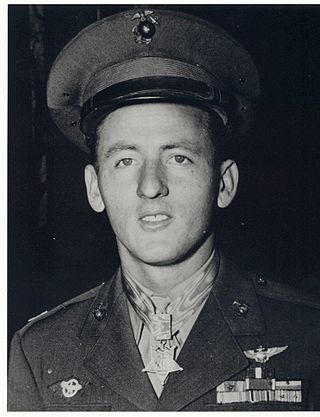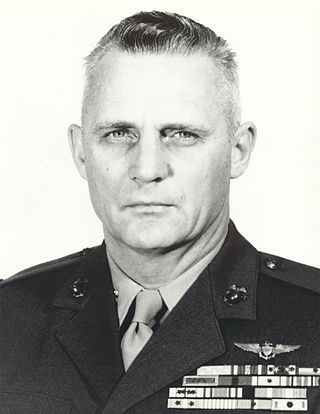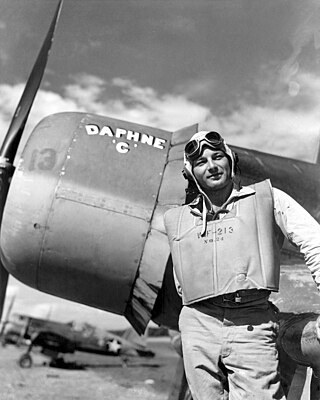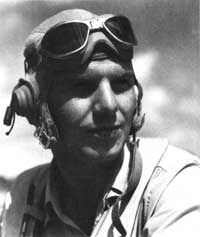
The Distinguished Flying Cross (DFC) is a military decoration of the United States Armed Forces. The medal was established on July 2, 1926, and is currently awarded to any persons who, after April 6, 1917, distinguish themselves by single acts of heroism or extraordinary achievement while participating in aerial flight. Both heroism and extraordinary achievement are entirely distinctive, involving operations that are not routine. The medal may be awarded to friendly foreign military members in ranks equivalent to U.S. Pay Grade of O-6 and below, in actual combat in support operations.

Jefferson Joseph DeBlanc was an American World War II Marine Corps fighter pilot and flying ace, credited with shooting down nine Japanese aircraft during two tours of duty in the Pacific at Guadalcanal and Okinawa. On January 31, 1943, despite mechanical problems with his aircraft, he pressed forward with a mission and shot down five Japanese aircraft in minutes before being shot down himself. DeBlanc parachuted to safety and was rescued by native islanders, traded for a sack of rice, and picked up by a Navy seaplane. He received the Medal of Honor for his actions that day. He served in the Marine Corps Reserve until 1972. In that time, he also taught school and completed graduate and doctoral degrees in math, physics and education.

Kenneth Ambrose Walsh was a United States Marine Corps lieutenant colonel and a Medal of Honor recipient who was the fourth ranking USMC fighter ace in World War II with a record of 21 enemy planes destroyed. He also served in Korea during the first year of the Korean War and retired from the Marine Corps in February 1962.

Robert Murray Hanson was a United States Marine Corps flying ace who shot down 25 Japanese planes from the South Pacific skies. He posthumously received the Medal of Honor. One of five children, he is the elder brother of Edith Hanson and Earl Dorchester Hanson.

James Elms Swett was a United States Marine Corps fighter pilot and flying ace during World War II. He was awarded the United States' highest military decoration, the Medal of Honor, for actions while a division flight leader in VMF-221 over Guadalcanal on April 7, 1943. He downed a total of 15.5 enemy aircraft during the war, earning two Distinguished Flying Crosses and five Air Medals.

Marine Fighting Squadron 132 (VMF-132) was a fighter squadron in the United States Marine Corps. The squadron, also known as “The Crying Red Asses”, fought in World War II as a dive bomber unit during the Battle of Guadalcanal as part of the Cactus Air Force and later fought in the Central Solomon Islands. The squadron was decommissioned shortly after the end of the war but was reactivated in the Marine Air Reserve flying out of Floyd Bennett Field in Brooklyn, New York. They were again decommissioned sometime after 1958.

Richard C. Mangrum was a United States Marine Corps lieutenant general who served as Assistant Commandant of the Marine Corps from 1965 to 1967. Mangrum was a Marine Corps aviator who was awarded the Navy Cross and the Distinguished Flying Cross for his actions during the Guadalcanal Campaign in World War II.
Frank Ackerman Hill was an American veteran and WWII Fighter Ace who served in the U.S. Army Air Forces and the U.S. Air Force.

James Norman Cupp was a United States Marine Corps aviator during World War II. Cupp was a double flying ace with at least 12 aerial victories in the Solomon Islands during three months of World War II. He was a recipient of the Navy Cross, the navy's second highest military decoration for valor and was a four time recipient of the Distinguished Flying Cross. Also a Korean War veteran, he retired as a colonel to Manassas, Virginia, in 1968.

Frederick Rounsville "Fritz" Payne Jr. was a World War II Ace and a brigadier general in the United States Marine Corps. Payne was awarded the Navy Cross for service with VMF-212.

Gerald Richard Johnson was a World War II flying ace who flew for the United States Army Air Forces. Johnson commanded the 9th Fighter Squadron and 49th Fighter Group, and became the fourth ranking fighter ace in the Pacific during World War II. He ended his war career with 22 kills.

Donald Nathan Aldrich was a United States Marine Corps Reserve captain and World War II flying ace. With 20 victories, Aldrich was the fifth-highest-scoring Marine Corps ace of the war. He joined the Royal Canadian Air Force after the United States Army Air Corps refused him because he was married. Aldrich became an instructor pilot and transferred to the United States Marine Corps in late 1942. He joined VMF-215 in the Solomon Islands campaign in June 1943, flying the Vought F4U Corsair. Aldrich added to his 20 victories in three combat tours with six probables, the highest total number of probables in the Marine Corps. Postwar, Aldrich continued to serve in the Marine Corps and was killed in a 1947 plane crash.
Phillip Cunliffe DeLong was a highly decorated United States Marine Corps officer. He was a flying ace credited with shooting down over 11 enemy aircraft during World War II and two more during the Korean War.

Dean Samuel "Diz" Laird was the only U.S. Navy ace to have combat victories in both the Pacific and European theaters of World War II. He served in World War II, the Korean War, and the Vietnam War, and is given credit for 5.75 aerial victories. Laird flew 138 fighter missions during World War II. and was awarded the Distinguished Flying Cross and the Congressional Gold Medal, among other honors.

Clayton Kelly Gross from Walla Walla, Washington was a Army Air Forces World War II Ace who shot down 6 enemy planes over Europe. Gross also flew planes in the D-Day invasion of Normany, France both on June 5 and 6, 1944. He was a recipient of the American Fighter Aces Congressional Gold Medal, the Distinguished Flying Cross and the Silver Star. He flew in 105 combat missions during WWII.

CptJames Francis Rigg from Saginaw, Michigan was a World War II Double Ace pilot who shot down eleven Japanese aircraft in the Pacific Theatre of World War II, including a Japanese Ace.
MajErnest Shipman U.S. Army Air Force from Saginaw, Michigan was an American World War II Ace pilot who shot down seven aircraft in the Mediterranean theatre of World War II.

MajFletcher Eugene Adams was a U.S. Army Air Forces World War II flying ace who shot down nine enemy aircraft in the European theatre of World War II. Adams was murdered after being shot down.

Ernest Charles Fiebelkorn was a United States Army Air Force fighter ace who was credited with shooting down 9 aircraft during World War II, making him the highest scoring fighter ace of the 20th Fighter Group. He was killed in action in 1950, during the Korean War.

Norman E. Olson was a U.S. Army Air Forces World War II flying ace. He shot down seven enemy aircraft in the European theatre of World War II. Olson died in aerial combat on April 8, 1944. He was the first Ace pilot of the 355th Fighter Group.


















